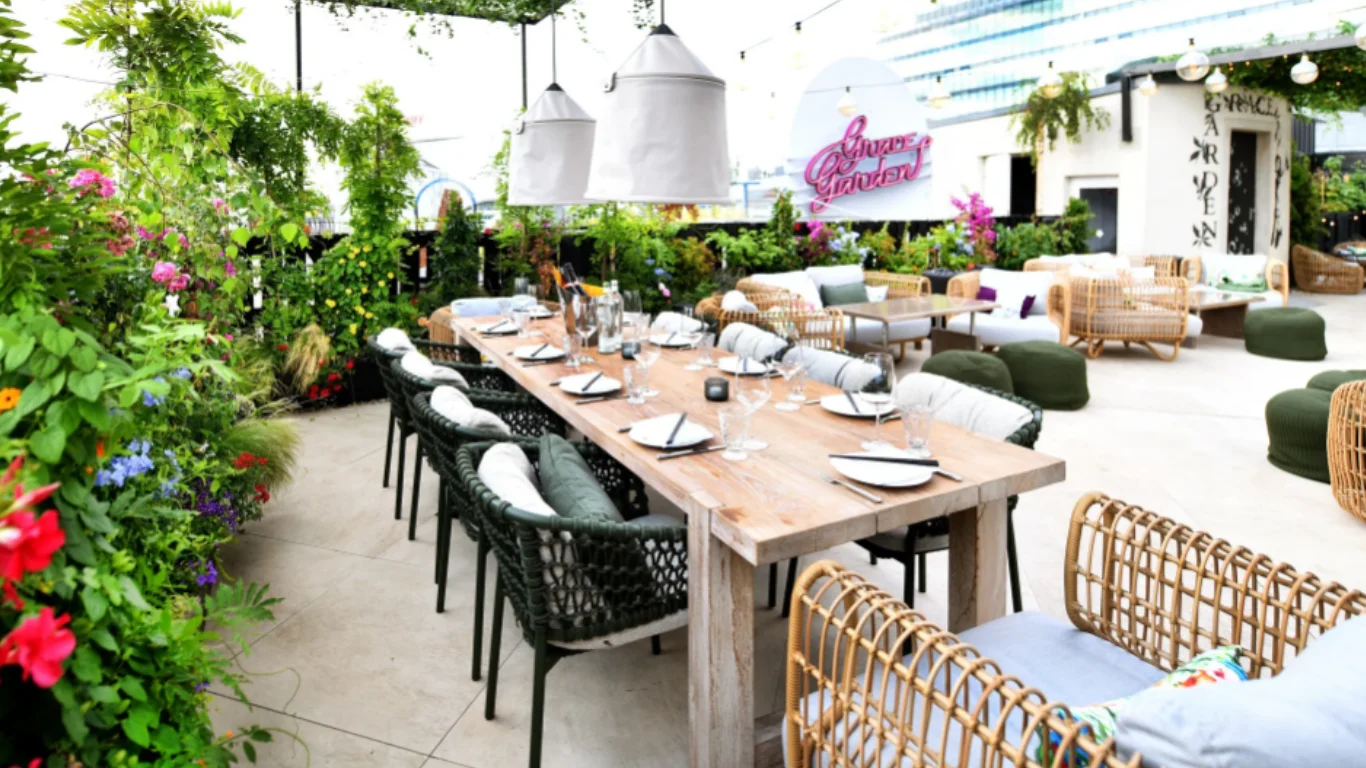Outdoor dining has always held a special charm, but in recent years it has taken on new meaning. Customers no longer see patio seating only as a place to enjoy a meal outside. They view it as part of a restaurant’s story, a reflection of its values, and increasingly, a signal of its responsibility toward the planet. Restaurants that commit to sustainable outdoor furniture are not just decorating their gardens; they are shaping perceptions.
An outdoor garden offers the perfect canvas for eco-friendly restaurant furniture design and placement. Reclaimed wood tables, bamboo chairs, and recycled plastic benches stand as reminders that comfort can coexist with care for the environment. Studies show that nearly seven out of ten diners prefer businesses that adopt visible sustainable practices, and the eco-friendly furniture market is expected to surpass eighty billion dollars within the next decade. The outdoor furniture sector is growing steadily at an annual rate of five to six percent, driven by the popularity of outdoor living. Choosing sustainable seating has never been more relevant.
Materials that Make a Difference
The foundation of any green initiative in restaurant design begins with the selection of materials. Recycled plastics, once destined for landfills, are now being reborn as durable chairs and benches that withstand rain and sun. Bamboo, known for its rapid regrowth, is proving to be a worthy alternative to traditional timber. Reclaimed wood, with its distinct character, not only prevents waste but also lends unique charm to every piece of furniture.
Metals such as aluminum and steel remain popular because of their strength and high recyclability. When paired with powder-coating, they resist corrosion and last for years. Finishes also matter, and water-based or low-VOC coatings protect both workers and diners from harmful chemicals. Cushions and upholstery increasingly come from recycled fibers and organic fabrics, softening the experience without harming the planet. Biodegradable composites are also entering the market, providing restaurateurs with even more options. Choosing FSC-certified wood or other verified sources helps prevent deforestation, while selecting locally sourced materials reduces emissions from long transport routes and supports the nearby economy.
Durability Meets Sustainability
Furniture built to last is furniture that protects the environment. Every time a chair or table is replaced prematurely, resources are consumed and waste is generated. Weather-resistant designs, such as those made from FSC-certified wood treated for outdoor use or steel protected with powder coatings, keep furniture looking new through years of exposure.
Sunlight is another factor. UV-protected seating helps maintain color and structure even under intense sunlight, so always use premium materials, regardless of the project. Modular furniture that allows for part replacement extends life even further, preventing complete disposal when only one piece fails. Quality is worth the initial cost because it pays for itself in the form of longevity. Research shows that extending the lifespan of furniture by just a few years can significantly reduce greenhouse gas emissions and decrease the overall number of products manufactured.
Durable furniture not only reduces waste but also lowers the need for frequent replacement, which helps keep long-term costs in check. Designs made for repairability, with screws, standard fittings, and replaceable components, give restaurateurs the ability to refresh rather than discard. It is a model of sustainability that benefits both business and the environment.
Designing for Comfort and Ecology
Outdoor seating must serve diners as well as ideals. Ergonomic designs ensure that eco-friendly choices do not compromise comfort. Lightweight yet sturdy chairs allow for flexibility in layout and adapt easily to changing needs. Natural textures and tones blend seamlessly with the greenery, creating harmony between the furniture and the garden.
Cushions crafted from recycled fabrics or organic textiles add softness while staying true to ecological goals. In warmer months, seating designed for shade reduces overheating, while thoughtful layouts that encourage airflow support natural cooling. Green design principles influence not only the look but also the function of furniture, demonstrating that beauty and responsibility can be aligned.
Some restaurants are pushing the boundaries of creativity by merging seating with landscaping. Built-in planters, trellises, or integrated greenery turn ordinary benches into living installations. Others prepare for seasonal shifts by adding adjustable shade, protective covers, or movable elements to keep furniture usable throughout the year. Comfort becomes part of a bigger picture that balances ecology with experience.
Trends Shaping Sustainable Outdoor Dining
The movement toward zero-waste and circular economy principles is shaping new trends in restaurant design. Furniture is now being built to serve multiple purposes, acting as planters, storage units, or decorative pieces. Recycled materials are being transformed into bold, stylish statements, demonstrating that sustainability can be both fashionable and functional.
Local sourcing has become increasingly important, as it reduces the environmental impact of long-distance shipments while supporting regional artisans. Certifications such as FSC, Cradle to Cradle, and GreenGuard provide reassurance that materials meet strict ecological standards. At the same time, restaurants are discovering marketing value in incorporating their eco-friendly furniture into the guest experience. Many create “Instagrammable” seating areas in outdoor gardens, drawing attention to both design and responsibility.
The numbers underline the importance of this trend. The global outdoor furniture market is projected to grow to over $80 billion within the next decade, with sustainability playing a significant role in this growth. Technology is also entering the picture, with smart furniture designs that incorporate solar lighting, built-in charging stations, or modular setups. Transparency is becoming increasingly essential as customers want to know not only how furniture looks but also where it comes from, how it is made, and what happens to it at the end of its life.
Practical Steps for Restaurateurs
Adopting eco-friendly patio seating begins with finding the right partners. Suppliers who specialize in sustainable furniture can guide restaurateurs toward options that meet both aesthetic and environmental needs. Cost is always a concern, but balancing the initial investment against the savings of fewer replacements reveals the actual value of quality.
Educating both staff and diners about these choices enhances their impact. A small plaque or menu note explaining that chairs are made of reclaimed wood or recycled plastic can spark appreciation and loyalty. Old furniture need not become waste either, as many businesses find creative ways to repurpose or donate it.
Eco-friendly furniture choices also fit into broader sustainability efforts. They can contribute to green certifications, sustainability reports, and marketing strategies. Maintaining furniture properly with simple care extends life further, reinforcing the commitment. Restaurateurs can plan budgets for small, medium, and significant investments, allowing them to phase in sustainable seating over time. Seasonal planning is also essential, as storing or protecting outdoor pieces during the winter helps them last longer. Taken together, these steps create a cohesive design story that reflects responsibility and vision.
Seating the Future: Eco Choices That Last
Eco-friendly patio seating has evolved into more than just a trend. It is a practical investment, a design choice, and a symbol of values all at once. Restaurants that adopt sustainable seating practices are creating dining experiences that align with modern expectations while preparing for the challenges of tomorrow.
Furniture plays a significant role in hospitality that many may not realize. A garden filled with reclaimed wood benches, bamboo chairs, and recycled cushions is more than decoration. It is a message that beauty, comfort, and environmental care can exist in harmony. Every decision, from material to layout, carries weight in reducing waste and cutting emissions.
Outdoor seating has the potential to become a living example of what responsible behavior looks and feels like. As the hospitality industry moves forward, what guests sit on will matter almost as much as what they are served. In a world where sustainability increasingly defines success, eco-friendly patio seating is a choice that lasts.







